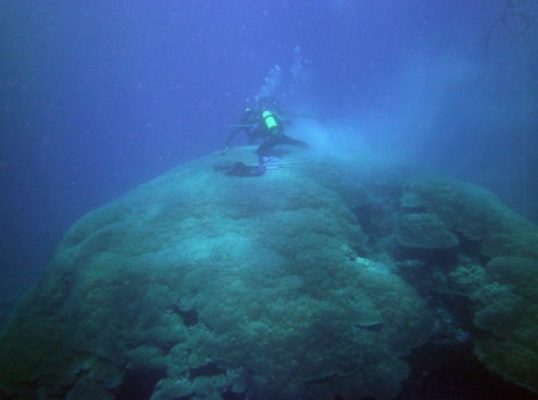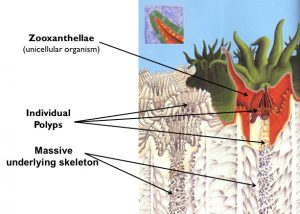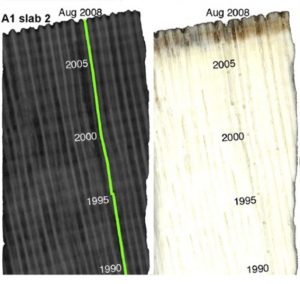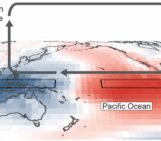
Name of proxy:
Coral
Type of record:
Oceanic variability
Paleoenvironment:
Fringing reefs, barrier reefs, or atoll
Period of time investigated:
Mainly the last 200 years
How does it works ?
What we usually picture as a coral is actually a colony of tiny living animals called coral polyps, which are closely related to jellyfish or anemones. They live in symbiosis with photosynthetic algae called Zooxanthellae (Figure 1).
Each polyp secretes a skeleton made of aragonite -a form of calcium carbonate- whose chemical composition depends on ambient oceanic and climatic conditions. Coral skeletons can therefore serve as monitors of the past oceanic and climatic variability through time (Figure 2).
Corals are distributed in the tropical belt mostly in the central and western Pacific, the Indian Ocean, and the Caribbean. These areas are also the most affected by climate variability such as the El Niño Southern Oscillation (ENSO) phenomenon. At interannual time scale, this phenomenon influences worldwide patterns of sea surface temperature (SST). Our present understanding of ENSO variability is limited by the short duration of instrumental records. In the current context of climate change, we need to understand the past variability of this phenomenon to be able to predict its future evolution. A proxy for past SST changes in the tropical oceans is therefore highly desirable to extend the length of the instrumental record.
Key Findings
Coral skeletal Sr/Ca have been shown to be an accurate tracer (“proxy”) of SST at many sites (Corrège, 2006). There is an inverse relationship between coral Sr/Ca values and SST conditions, with low Sr/Ca values corresponding to high SST environments and vice versa. Regression of coral Sr/Ca to instrumental SST (Figure 3) leads to a calibration equation that allows reconstruction of SST variability further back in time. SST records that span at least the last 200 years allow to differentiate the contributions of natural climate variability from those that are anthropogenically forced (Solomon et al., 2011). These results place coral as a perfect tool to reconstruct past oceanic variability which leads to a better understanding of past climate variability and a tremendously useful record to help predict future changes.

Figure 3: Time series of Sr/Ca from a living coral from New Caledonia and local SST (left). Calibration of Sr/Ca vs. SST. Sr/Ca appears to be a robust SST tracer (right).
Further readings
Corrège, T. (2006), Sea surface temperature and salinity reconstruction from coral geochemical tracers, Palaeogeography, Palaeoclimatology, Palaeoecology, 232(2-4), 408-428, doi:10.1016/j.palaeo.2005.10.014.
DeLong, K. L., J. A. Flannery, C. R. Maupin, R. Z. Poore, and T. M. Quinn (2011), A coral Sr/Ca calibration and replication study of two massive corals from the Gulf of Mexico, Palaeogeography, Palaeoclimatology, Palaeoecology, 307, 117–128, doi:10.1016/j.palaeo.2011.05.005.
Solomon A, et al. (2011), Distinguishing the roles of natural and anthropogenically forced decadal climate variability: Implications for prediction. Bull Am Meteorol Soc, 92:141–156.
Veron, J.E.N. (1986), Corals of Australia and the Indo-Pacific. Angus and Robertson:London/Sidney.
Edited by Caroline Jacques and Célia Sapart




